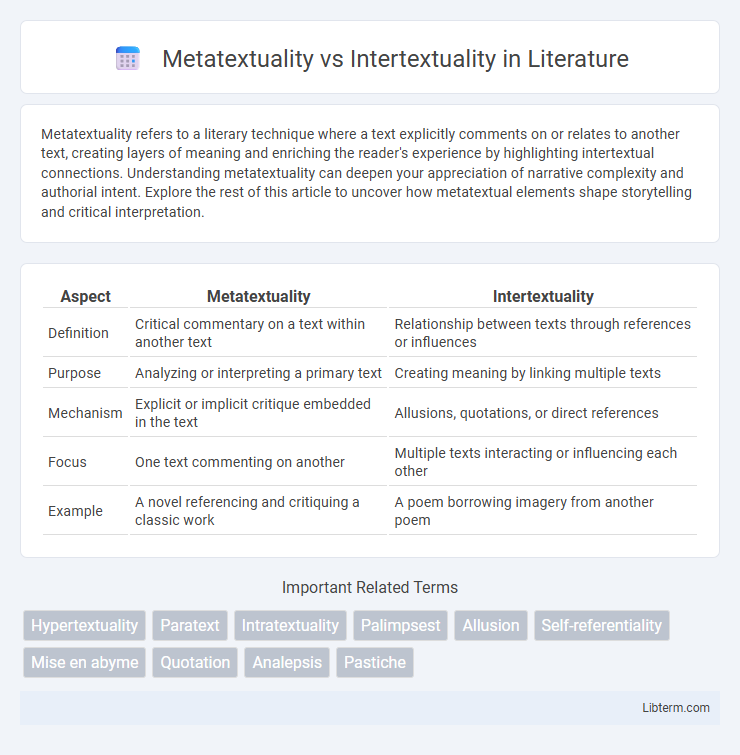Metatextuality refers to a literary technique where a text explicitly comments on or relates to another text, creating layers of meaning and enriching the reader's experience by highlighting intertextual connections. Understanding metatextuality can deepen your appreciation of narrative complexity and authorial intent. Explore the rest of this article to uncover how metatextual elements shape storytelling and critical interpretation.
Table of Comparison
| Aspect | Metatextuality | Intertextuality |
|---|---|---|
| Definition | Critical commentary on a text within another text | Relationship between texts through references or influences |
| Purpose | Analyzing or interpreting a primary text | Creating meaning by linking multiple texts |
| Mechanism | Explicit or implicit critique embedded in the text | Allusions, quotations, or direct references |
| Focus | One text commenting on another | Multiple texts interacting or influencing each other |
| Example | A novel referencing and critiquing a classic work | A poem borrowing imagery from another poem |
Understanding Metatextuality: Definition and Scope
Metatextuality involves explicit commentary by one text on another, emphasizing critique or interpretation within the narrative framework. It extends beyond mere reference, offering a meta-level dialogue where the primary text reflects on or evaluates the secondary text's meaning and significance. This concept contrasts with intertextuality, which broadly encompasses the relationships and influences between texts without necessarily involving direct commentary or analysis.
Defining Intertextuality: Key Characteristics
Intertextuality refers to the shaping of a text's meaning by another text, involving direct or indirect references, quotations, or allusions. Key characteristics include the presence of explicit or implicit connections that allow readers to recognize and interpret these relationships, enriching the understanding of both texts. Unlike metatextuality, which comments on or critiques another text, intertextuality emphasizes the interconnectedness and dialogic interaction between texts.
Historical Origins of Metatextuality and Intertextuality
Metatextuality, a term introduced by Gerard Genette in the 1970s, traces its origins to structuralist and post-structuralist theories, emphasizing explicit critical commentary within a text about another text. Intertextuality, coined by Julia Kristeva in the 1960s, derives from Mikhail Bakhtin's ideas on dialogism, highlighting the interconnectedness and influence of texts through allusions, quotations, and thematic echoes. Both concepts emerged from the evolution of literary theory, seeking to explain how texts reference and reshape one another across historical and cultural contexts.
Core Differences Between Metatextuality and Intertextuality
Metatextuality involves explicit commentary or critique of one text within another, emphasizing the relationship through analysis or evaluation. Intertextuality encompasses the broader connections through references, quotations, or allusions between texts, highlighting the presence of shared meanings. The core difference lies in metatextuality's critical stance compared to intertextuality's integrative references.
Functions of Metatextuality in Literature
Metatextuality functions in literature by providing critical commentary on the text itself, enabling readers to engage with the work's structure, themes, and language at a deeper level. It reveals the author's self-reflective stance and highlights the relationship between the text and its literary context, often questioning or clarifying meanings. This self-referential approach distinguishes metatextuality from intertextuality, which primarily involves connections between different texts.
Intertextuality in Literary Analysis: Methods and Examples
Intertextuality in literary analysis involves examining the relationships between texts to uncover deeper meanings, connections, and influences that shape a work's interpretation. Methods include identifying direct quotations, allusions, and thematic parallels, as well as analyzing genre conventions and narrative structures that reference other texts. Examples include tracing Shakespearean motifs in modern novels or exploring how postmodern works incorporate and subvert canonical literature to create layered interpretations.
Metatextuality in Modern Narratives
Metatextuality in modern narratives involves explicit commentary on the text itself, often through self-reflective or self-referential techniques that highlight the construction and interpretation of the narrative. This practice contrasts with intertextuality, which features the incorporation of references or quotations from other texts to create meaning through interrelatedness. Contemporary authors use metatextuality to engage readers in a critical dialogue about storytelling processes, narrative reliability, and the boundaries between fiction and reality.
Intertextual Techniques: Parody, Allusion, and Quotation
Intertextuality employs techniques such as parody, which humorously imitates a work to critique or celebrate it, allusion, subtly referencing another text to enrich meaning, and quotation, directly incorporating excerpts to establish explicit connections. These techniques create layered meanings and dialogues between texts, enhancing reader engagement by invoking shared cultural or literary knowledge. Understanding these intertextual methods reveals how authors construct complex narratives through interconnected textual relationships.
Impact of Metatextuality and Intertextuality on Reader Interpretation
Metatextuality impacts reader interpretation by prompting critical reflection on the text's content, encouraging awareness of the relationship between the text and its commentary, which enhances analytical thinking. Intertextuality influences interpretation through the recognition of references, quotations, or allusions to other texts, enriching the reading experience by creating layers of meaning and cultural context. Both metatextuality and intertextuality deepen reader engagement by fostering connections that challenge surface-level understanding and promote interpretive complexity.
Choosing Between Metatextuality and Intertextuality in Academic Studies
Choosing between metatextuality and intertextuality in academic studies hinges on the analytical focus: metatextuality involves critical commentary on a text, revealing its underlying assumptions and ideologies, while intertextuality examines the relationships and influences between texts. Researchers prioritize metatextuality when exploring interpretative frameworks or authorial intent, and intertextuality when mapping textual dialogues, cultural references, or literary traditions. Each approach offers distinct insights, with metatextuality deepening theoretical critique and intertextuality enriching contextual understanding.
Metatextuality Infographic

 libterm.com
libterm.com